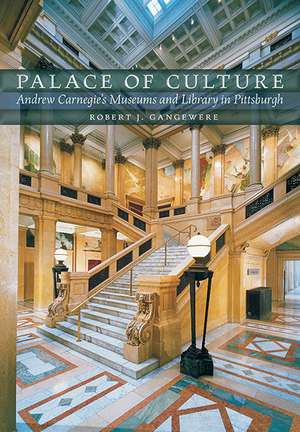Palace of Culture: Andrew Carnegie's Museums and Library in Pittsburgh
Autor Robert J. Gangewereen Limba Engleză Paperback – 15 noi 2013
Andrew Carnegie is remembered as one of the world’s great philanthropists. As a boy, he witnessed the benevolence of a businessman who lent his personal book collection to laborer’s apprentices. That early experience inspired Carnegie to create the “Free to the People” Carnegie Library in 1895 in Pittsburgh, Pennsylvania. In 1896, he founded the Carnegie Institute, which included a music hall, art museum, and science museum. Carnegie deeply believed that education and culture could lift up the common man and should not be the sole province of the wealthy. Today, his Pittsburgh cultural institution encompasses a library, music hall, natural history museum, art museum, science center, the Andy Warhol Museum, and the Carnegie International art exhibition.
In Palace of Culture, Robert J. Gangewere presents the first history of a cultural conglomeration that has served millions of people since its inception and inspired the likes of August Wilson, Andy Warhol, and David McCullough. In this fascinating account, Gangewere details the political turmoil, budgetary constraints, and cultural tides that have influenced the caretakers and the collections along the way. He profiles the many benefactors, trustees, directors, and administrators who have stewarded the collections through the years. Gangewere provides individual histories of the library, music hall, museums, and science center, and describes the importance of each as an educational and research facility.
Moreover, Palace of Culture documents the importance of cultural institutions to the citizens of large metropolitan areas. The Carnegie Library and Institute have inspired the creation of similar organizations in the United States and serve as models for museum systems throughout the world.
In Palace of Culture, Robert J. Gangewere presents the first history of a cultural conglomeration that has served millions of people since its inception and inspired the likes of August Wilson, Andy Warhol, and David McCullough. In this fascinating account, Gangewere details the political turmoil, budgetary constraints, and cultural tides that have influenced the caretakers and the collections along the way. He profiles the many benefactors, trustees, directors, and administrators who have stewarded the collections through the years. Gangewere provides individual histories of the library, music hall, museums, and science center, and describes the importance of each as an educational and research facility.
Moreover, Palace of Culture documents the importance of cultural institutions to the citizens of large metropolitan areas. The Carnegie Library and Institute have inspired the creation of similar organizations in the United States and serve as models for museum systems throughout the world.
Preț: 243.90 lei
Nou
Puncte Express: 366
Preț estimativ în valută:
46.68€ • 48.55$ • 39.12£
46.68€ • 48.55$ • 39.12£
Carte disponibilă
Livrare economică 21 februarie-07 martie
Preluare comenzi: 021 569.72.76
Specificații
ISBN-13: 9780822962854
ISBN-10: 0822962853
Pagini: 360
Ilustrații: 80 b&w photos, 8 page color insert
Dimensiuni: 178 x 254 x 18 mm
Greutate: 0.75 kg
Ediția:1
Editura: University of Pittsburgh Press
Colecția University of Pittsburgh Press
ISBN-10: 0822962853
Pagini: 360
Ilustrații: 80 b&w photos, 8 page color insert
Dimensiuni: 178 x 254 x 18 mm
Greutate: 0.75 kg
Ediția:1
Editura: University of Pittsburgh Press
Colecția University of Pittsburgh Press
Recenzii
“In Palace of Culture, Robert Gangewere chronicles the complex story of Andrew Carnegie’s Institute and Library. Gangewere succeeds admirably in presenting the history of this extraordinary organization and its individual units, each of which has its own tale. This study provides valuable insights for those interested in museum studies and nonprofit management as well as for those seeking a better understanding of Carnegie’s philanthropism and the city of Pittsburgh, which has benefited so greatly from his generosity.”
—Edward A. Aiken, Syracuse University
—Edward A. Aiken, Syracuse University
“This comprehensive history of Pittsburgh’s Carnegie Institute and Library fills an important gap in the historiography of American cultural institutions. It makes for a fascinating account that not only is a tribute to Andrew Carnegie’s vision but also demonstrates that libraries, museums, and concert halls can have a powerful, even transformative impact on cities.”
—Petra ten-Doesschate Chu, Seton Hall University
—Petra ten-Doesschate Chu, Seton Hall University
“Gangewere captures—like no one else could—how Carnegie’s romantic vision for his ‘Palace of Culture’ has been reshaped and fulfilled over the past century in Pittsburgh. A must-read for those who strive to understand the legacy of Carnegie and his contemporaries left for this city and for museums and libraries everywhere.”
—Robert C. Wilburn, Carnegie Mellon University
—Robert C. Wilburn, Carnegie Mellon University
“Handsome, meticulously researched and beautifully written . . . Mr. Gangewere’s narrative greatly enhances our appreciation of the Carnegie Museums and Library, and conversely, a visit to any of the Carnegie institutions would serve to augment and flesh out any reading of this book.”
—Pittsburgh Post-Gazette
—Pittsburgh Post-Gazette
“Gangewere does an excellent job of presenting integral information to the discussion of museum theory and practice through the lens of an immensely popular institute founded by one of Pittsburgh’s historical giants.”
—Pennsylvania History
—Pennsylvania History
Notă biografică
Robert J. Gangewere is a former editor of Carnegie Magazine and adjunct professor of English at Carnegie Mellon University. He is the author or editor of several books, including The Bridges of Pittsburgh and Allegheny County and The Exploited Eden: Literature on the American Environment.
Descriere
The first history of The Carnegie museums and library of Pittsburgh, a cultural conglomeration that has served millions of people since its inception. Gangewere details the political turmoil, budgetary constraints, and cultural tides that have influenced the caretakers and the collections along the way. He provides individual histories of the library, music hall, museums, and science center, and describes the importance of each as an educational and research facility.


